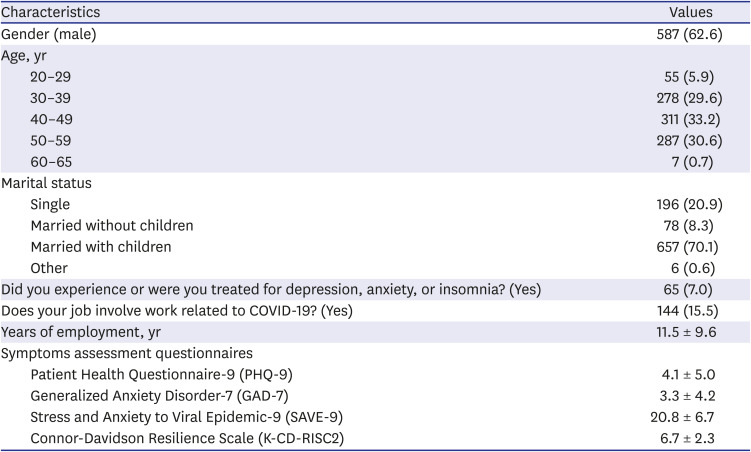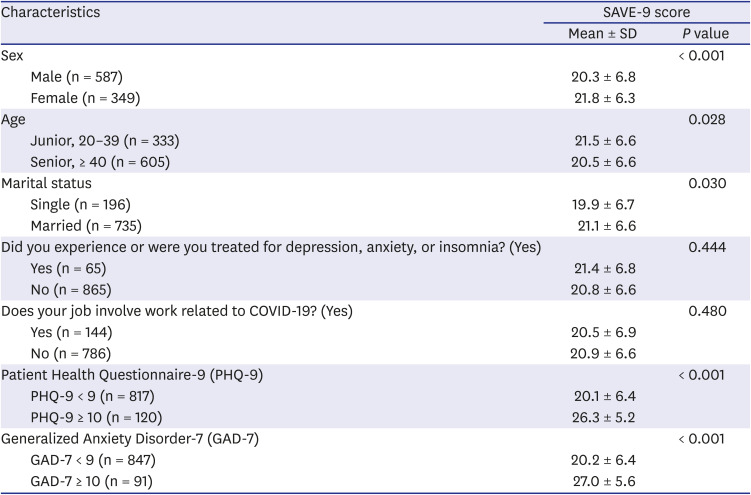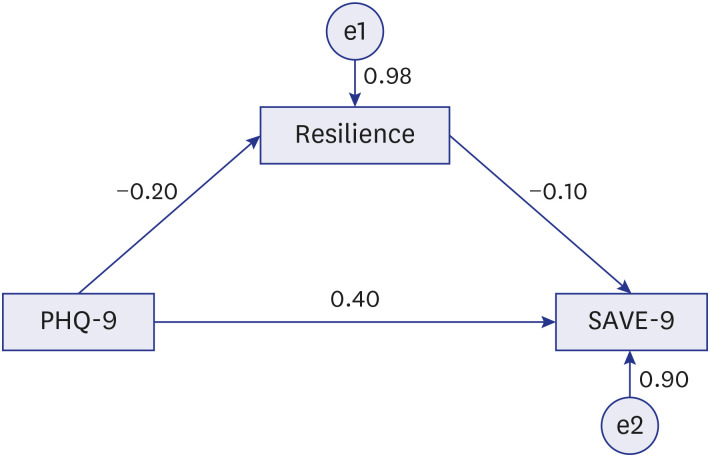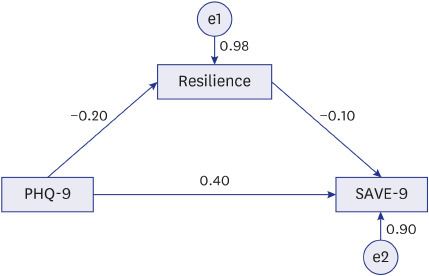2. Lai J, Ma S, Wang Y, Cai Z, Hu J, Wei N, et al. Factors associated with mental health outcomes among health care workers exposed to coronavirus disease 2019. JAMA Netw Open. 2020; 3(3):e203976. PMID:
32202646.

3. Carmassi C, Foghi C, Dell'Oste V, Cordone A, Bertelloni CA, Bui E, et al. PTSD symptoms in healthcare workers facing the three coronavirus outbreaks: what can we expect after the COVID-19 pandemic. Psychiatry Res. 2020; 292:113312. PMID:
32717711.

4. Trumello C, Bramanti SM, Ballarotto G, Candelori C, Cerniglia L, Cimino S, et al. Psychological adjustment of healthcare workers in Italy during the COVID-19 pandemic: differences in stress, anxiety, depression, burnout, secondary trauma, and compassion satisfaction between frontline and non-frontline professionals. Int J Environ Res Public Health. 2020; 17(22):E8358. PMID:
33198084.

5. Liu Z, Wu J, Shi X, Ma Y, Ma X, Teng Z, et al. Mental health status of healthcare workers in China for COVID-19 epidemic. Ann Glob Health. 2020; 86(1):128. PMID:
33102148.

6. Hu Q, Hu X, Zheng B, Li L. Mental health outcomes among civil servants aiding in coronavirus disease 2019 control. Front Public Health. 2021; 9:601791. PMID:
33996707.

7. Rossi R, Socci V, Pacitti F, Di Lorenzo G, Di Marco A, Siracusano A, et al. Mental health outcomes among frontline and second-line health care workers during the coronavirus disease 2019 (COVID-19) pandemic in Italy. JAMA Netw Open. 2020; 3(5):e2010185. PMID:
32463467.

8. Schuster C, Weitzman L, Sass Mikkelsen K, Meyer-Sahling J, Bersch K, Fukuyama F, et al. Responding to COVID-19 through surveys of public servants. Public Adm Rev. 2020; 80(5):792–796.

9. Pappa S, Ntella V, Giannakas T, Giannakoulis VG, Papoutsi E, Katsaounou P. Prevalence of depression, anxiety, and insomnia among healthcare workers during the COVID-19 pandemic: a systematic review and meta-analysis. Brain Behav Immun. 2020; 88:901–907. PMID:
32437915.

10. Wang C, Pan R, Wan X, Tan Y, Xu L, McIntyre RS, et al. A longitudinal study on the mental health of general population during the COVID-19 epidemic in China. Brain Behav Immun. 2020; 87:40–48. PMID:
32298802.

11. Gao J, Zheng P, Jia Y, Chen H, Mao Y, Chen S, et al. Mental health problems and social media exposure during COVID-19 outbreak. PLoS One. 2020; 15(4):e0231924. PMID:
32298385.

12. Wang C, Pan R, Wan X, Tan Y, Xu L, Ho CS, et al. Immediate psychological responses and associated factors during the initial stage of the 2019 coronavirus disease (COVID-19) epidemic among the general population in China. Int J Environ Res Public Health. 2020; 17(5):E1729. PMID:
32155789.

13. Kujawa A, Green H, Compas BE, Dickey L, Pegg S. Exposure to COVID-19 pandemic stress: associations with depression and anxiety in emerging adults in the United States. Depress Anxiety. 2020; 37(12):1280–1288. PMID:
33169481.

14. Stavrakaki C, Vargo B. The relationship of anxiety and depression: a review of the literature. Br J Psychiatry. 1986; 149(1):7–16. PMID:
3535981.

15. Sadock BJ, Sadock VA, Ruiz P. Kaplan & Sadock's Synopsis of Psychiatry. 11th ed. Philadelphia, PA, USA: Wolters Kluwer;2015.
16. Rutter M. Implications of resilience concepts for scientific understanding. Ann N Y Acad Sci. 2006; 1094(1):1–12.

17. Bonanno GA. Loss, trauma, and human resilience: have we underestimated the human capacity to thrive after extremely aversive events? Am Psychol. 2004; 59(1):20–28. PMID:
14736317.

18. Cicchetti D. Resilience under conditions of extreme stress: a multilevel perspective. World Psychiatry. 2010; 9(3):145–154. PMID:
20975856.

19. Hu T, Zhang D, Wang J. A meta-analysis of the trait resilience and mental health. Pers Individ Dif. 2015; 76:18–27.

20. Dray J, Bowman J, Campbell E, Freund M, Wolfenden L, Hodder RK, et al. Systematic review of universal resilience-focused interventions targeting child and adolescent mental health in the school setting. J Am Acad Child Adolesc Psychiatry. 2017; 56(10):813–824. PMID:
28942803.

21. Chung S, Kim HJ, Ahn MH, Yeo S, Lee J, Kim K, et al. Development of the Stress and Anxiety to Viral Epidemics-9 (SAVE-9) scale for assessing work-related stress and anxiety in healthcare workers in response to COVID-19. PsyArXiv. Forthcoming. 2020.

23. Tavormina G, Tavormina MG, Franza F, Aldi G, Amici P, Amorosi M, et al. A new rating scale (SAVE-9) to demonstrate the stress and anxiety in the healthcare workers during the COVID-19 viral epidemic. Psychiatr Danub. 2020; 32(Suppl 1):5–9. PMID:
32890353.
24. Mosolova E, Chung S, Sosin D, Mosolov S. Stress and anxiety among healthcare workers associated with COVID-19 pandemic in Russia. Psychiatr Danub. 2020; 32(3-4):549–556. PMID:
33370765.

25. Okajima I, Chung S, Suh S. Validation of the Japanese version of Stress and Anxiety to Viral Epidemics-9 (SAVE-9) and relationship among stress, insomnia, anxiety, and depression in healthcare workers exposed to coronavirus disease 2019. Sleep Med. 2021; 84:397–402. PMID:
34265636.

26. Kroenke K, Spitzer RL, Williams JB. The PHQ-9: validity of a brief depression severity measure. J Gen Intern Med. 2001; 16(9):606–613. PMID:
11556941.
27. Shin C, Ko YH, An H, Yoon HK, Han C. Normative data and psychometric properties of the Patient Health Questionnaire-9 in a nationally representative Korean population. BMC Psychiatry. 2020; 20(1):194. PMID:
32354339.

28. Lee SH, Shin C, Kim H, Jeon SW, Yoon HK, Ko YH, et al. Validation of the Korean version of the Generalized Anxiety Disorder 7 self-rating Scale. Asia-Pac Psychiatry. Forthcoming. 2020.

29. Jeong HS, Kang I, Namgung E, Im JJ, Jeon Y, Son J, et al. Validation of the Korean version of the Connor-Davidson Resilience Scale-2 in firefighters and rescue workers. Compr Psychiatry. 2015; 59:123–128. PMID:
25744698.

30. Kim JH, Oh SS, Bae SW, Park EC, Jang SI. Gender discrimination in the workplace: effects on pregnancy planning and childbirth among South Korean women. Int J Environ Res Public Health. 2019; 16(15):E2672. PMID:
31357386.

31. Ahn MH, Shin YW, Suh S, Kim JH, Kim HJ, Lee KU, Chung S. High work-related stress and anxiety response to COVID-19 among healthcare workers in South Korea: SAVE study. JMIR Public Health Surveill. Forthcoming. 2020.

32. Nickell LA, Crighton EJ, Tracy CS, Al-Enazy H, Bolaji Y, Hanjrah S, et al. Psychosocial effects of SARS on hospital staff: survey of a large tertiary care institution. CMAJ. 2004; 170(5):793–798. PMID:
14993174.

33. Wu P, Fang Y, Guan Z, Fan B, Kong J, Yao Z, et al. The psychological impact of the SARS epidemic on hospital employees in China: exposure, risk perception, and altruistic acceptance of risk. Can J Psychiatry. 2009; 54(5):302–311. PMID:
19497162.

34. Mosheva M, Hertz-Palmor N, Dorman Ilan S, Matalon N, Pessach IM, Afek A, et al. Anxiety, pandemic-related stress and resilience among physicians during the COVID-19 pandemic. Depress Anxiety. 2020; 37(10):965–971. PMID:
32789945.

35. Labrague LJ, De Los Santos JA. COVID-19 anxiety among front-line nurses: Predictive role of organisational support, personal resilience and social support. J Nurs Manag. 2020; 28(7):1653–1661. PMID:
32770780.

36. Bozdağ F, Ergün N. Psychological resilience of healthcare professionals during COVID-19 pandemic. Psychol Rep. Forthcoming. 2020.

37. Barzilay R, Moore TM, Greenberg DM, DiDomenico GE, Brown LA, White LK, et al. Resilience, COVID-19-related stress, anxiety and depression during the pandemic in a large population enriched for healthcare providers. Transl Psychiatry. 2020; 10(1):291. PMID:
32820171.

38. Yıldırım M, Solmaz F. COVID-19 burnout, COVID-19 stress and resilience: Initial psychometric properties of COVID-19 Burnout Scale. Death Stud. Forthcoming. 2020.

39. Fox S, Lydon S, Byrne D, Madden C, Connolly F, O'Connor P. A systematic review of interventions to foster physician resilience. Postgrad Med J. 2018; 94(1109):162–170. PMID:
29018095.

40. Ungar M, Theron L. Resilience and mental health: how multisystemic processes contribute to positive outcomes. Lancet Psychiatry. 2020; 7(5):441–448. PMID:
31806473.

41. Southwick SM, Vythilingam M, Charney DS. The psychobiology of depression and resilience to stress: implications for prevention and treatment. Annu Rev Clin Psychol. 2005; 1(1):255–291. PMID:
17716089.

42. Herrero R, Mira A, Cormo G, Etchemendy E, Baños R, García-Palacios A, et al. An internet based intervention for improving resilience and coping strategies in university students: study protocol for a randomized controlled trial. Internet Interv. 2019; 16:43–51. PMID:
30775264.











 PDF
PDF Citation
Citation Print
Print




 XML Download
XML Download